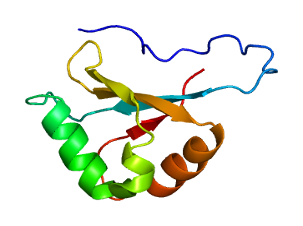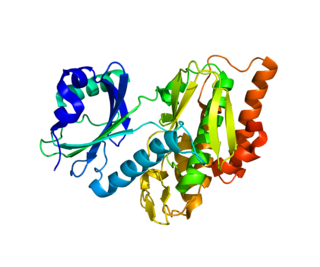
RNA splicing is a process in molecular biology where a newly-made precursor messenger RNA (pre-mRNA) transcript is transformed into a mature messenger RNA (mRNA). It works by removing all the introns and splicing back together exons. For nuclear-encoded genes, splicing occurs in the nucleus either during or immediately after transcription. For those eukaryotic genes that contain introns, splicing is usually needed to create an mRNA molecule that can be translated into protein. For many eukaryotic introns, splicing occurs in a series of reactions which are catalyzed by the spliceosome, a complex of small nuclear ribonucleoproteins (snRNPs). There exist self-splicing introns, that is, ribozymes that can catalyze their own excision from their parent RNA molecule. The process of transcription, splicing and translation is called gene expression, the central dogma of molecular biology.

Pre-mRNA-processing factor 19 is a protein that in humans is encoded by the PRPF19 gene.

Ubiquitin-conjugating enzyme E2 G2 is a protein that in humans is encoded by the UBE2G2 gene.

REX2, RNA exonuclease 2 homolog , also known as REXO2, is an enzyme which in humans is encoded by the REXO2 gene.

Probable ATP-dependent RNA helicase DDX56 is an enzyme that in humans is encoded by the DDX56 gene.

Repressor of RNA polymerase III transcription MAF1 homolog is a protein that in humans is encoded by the MAF1 gene.

mRNA-capping enzyme is a protein that in humans is encoded by the RNGTT gene.

Methionine aminopeptidase 1 is an enzyme that in humans is encoded by the METAP1 gene.

Protein phosphatase 1G is an enzyme that in humans is encoded by the PPM1G gene.

60S ribosomal protein L30 is a protein that in humans is encoded by the RPL30 gene.

DNA-directed RNA polymerase III subunit RPC4 is an enzyme that in humans is encoded by the POLR3D gene.

RNA polymerase-associated protein LEO1 is an enzyme that in humans is encoded by the LEO1 gene.

Disintegrin and metalloproteinase domain-containing protein 11 is an enzyme that in humans is encoded by the ADAM11 gene.

tRNA -methyltransferase is an enzyme that in humans is encoded by the METTL1 gene.

DNA-directed RNA polymerase III subunit RPC5 is an enzyme that in humans is encoded by the POLR3E gene.

ATP-dependent RNA helicase DDX50 is an enzyme that in humans is encoded by the DDX50 gene.

GPI mannosyltransferase 2 is an enzyme that in humans is encoded by the PIGV gene.

tRNA-splicing endonuclease subunit Sen34 is an enzyme that in humans is encoded by the TSEN34 gene.

tRNA-splicing endonuclease subunit Sen2 is an enzyme that in humans is encoded by the TSEN2 gene.

Serine/threonine-protein kinase haspin is an enzyme that in humans is encoded by the GSG2 gene.






















